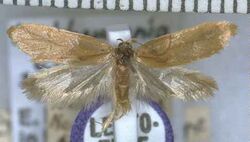Biology:Tingena eriphaea
| Tingena eriphaea | |
|---|---|

| |
| Male lectotype | |
| Scientific classification | |
| Domain: | Eukaryota |
| Kingdom: | Animalia |
| Phylum: | Arthropoda |
| Class: | Insecta |
| Order: | Lepidoptera |
| Family: | Oecophoridae |
| Genus: | Tingena |
| Species: | T. eriphaea
|
| Binomial name | |
| Tingena eriphaea (Meyrick, 1914)[1]
| |
| Synonyms[2] | |
| |
Tingena eriphaea is a species of moth in the family Oecophoridae.[2] It is endemic to New Zealand and has been found in Otago. This species is known to inhabit native beech forest.
Taxonomy
This species was first described by Edward Meyrick in 1914 using specimens collected at Ben Lomond at an altitude of 2500 ft in November and named Borkhausenia eriphaea.[3][4] In 1926 Alfred Philpott discussed and illustrated the genitalia of the male of this species.[5] In 1928 George Hudson also discussed and illustrated this species in his book The butterflies and moths of New Zealand.[4] In 1988 J. S. Dugdale placed this species within the genus Tingena.[2] The male lectotype is held at the Natural History Museum, London.[2]
Description
Meyrick described this species as follows:
♂. 19-20 mm. Head and thorax dark grey, apex of patagia and posterior edge of thorax pale ochreous. Palpi whitish irro rated with grey. Antennal ciliations 1. Abdomen grey. Forewings elongate, rather narrow, somewhat dilated posteriorly, costa gently arched, apex obtuse, termen very obliquely rounded ; lilac-brown, sometimes mixed with grey, anterior half of costa suffused with grey, scales of costal edge whitish from J onwards ; dorsum obscurely paler and ochreous-tinged from base to beyond middle, forming an undefined streak of which the upper edge is marked in middle with a black linear dot followed by a whitish mark : cilia pale ochreous suffasedly irrorated with grey. Hindwings grey ; cilia pale grey, on costa ochreous-whitish.[3]
Distribution
This species is endemic to New Zealand and has been found in its type locality of Ben Lomond in Otago as well as in Dunedin.[1][3][6]
Habitat
This species inhabits native beech forest on mountain sides.[4]
References
- ↑ 1.0 1.1 , pp. 462, Wikidata Q45922947
- ↑ 2.0 2.1 2.2 2.3 , pp. 101, Wikidata Q45083134
- ↑ 3.0 3.1 3.2 , pp. 107, Wikidata Q98606535
- ↑ 4.0 4.1 4.2 , pp. 264, Wikidata Q58593286
- ↑ , Wikidata Q110157185
- ↑ "Tingena eriphaea". 2021. https://www.aucklandmuseum.com/collections-research/collections/record/am_naturalsciences-object-183731.
Wikidata ☰ Q13860092 entry
 |


